Crispy Vegetable Pakora Recipe (Simple, Homestyle)
A simple, flavor-packed Vegetable Pakora recipe with tips to make them soft yet extra crispy. These are homestyle pakoras – light and airy, not heavy or dense like restaurant ones can be. Use onions and potatoes, plus cabbage, spinach, or any veggies you like. Tested to perfection!
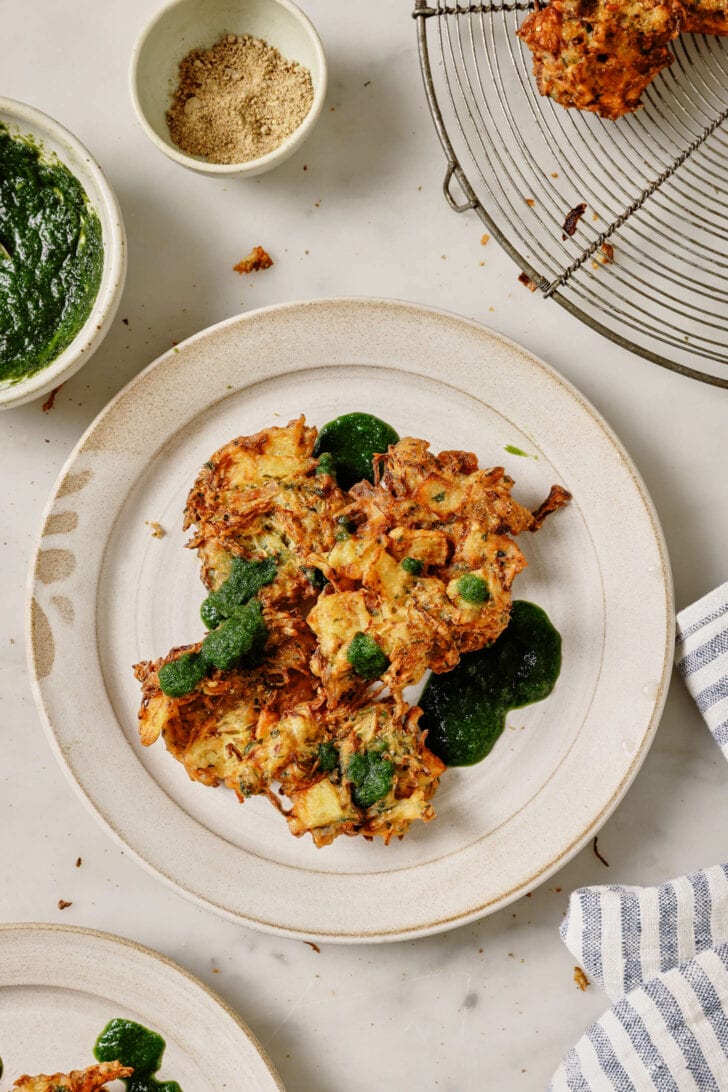
Want to save this post?
Enter your email below and get it sent straight to your inbox. Plus, get recipes & tips every week!
Navigation
Crispy Vegetable Pakora
Ahhhh Pakoras. Nothing can deter us from these little morsels of joy. They’re the 2nd most popular Iftar recipe (right after Fruit Chaat) and standard protocol for comfort on rainy days. It’s as if their crunch and warmth must accompany the chill of rain, alongside steaming cups of Chai. I thought I was somewhat disconnected from this cultural rain-Pakora phenomenon until I was driving home one day and it started raining. And I wanted pakoras so badly I could cry. Luckily a local restaurant had them and I felt all was redeemed.
That day I got lucky, but for the most part, restaurant Pakoras are inferior. They can be dense, doughy, and heavy. In contrast, homemade ones are usually light, airy, and vegetable-forward. These Pakoras are the ones I’ve grown up with – crispy, flavorful, with appropriate heat and a hint of tang.
What is Pakora/Pakoda?
Pakoras are Pakistani or North Indian-style fritters. Unlike American-style fritters, Pakoras are not round, but craggy-edged, and made with besan/gram flour instead of all-purpose flour.
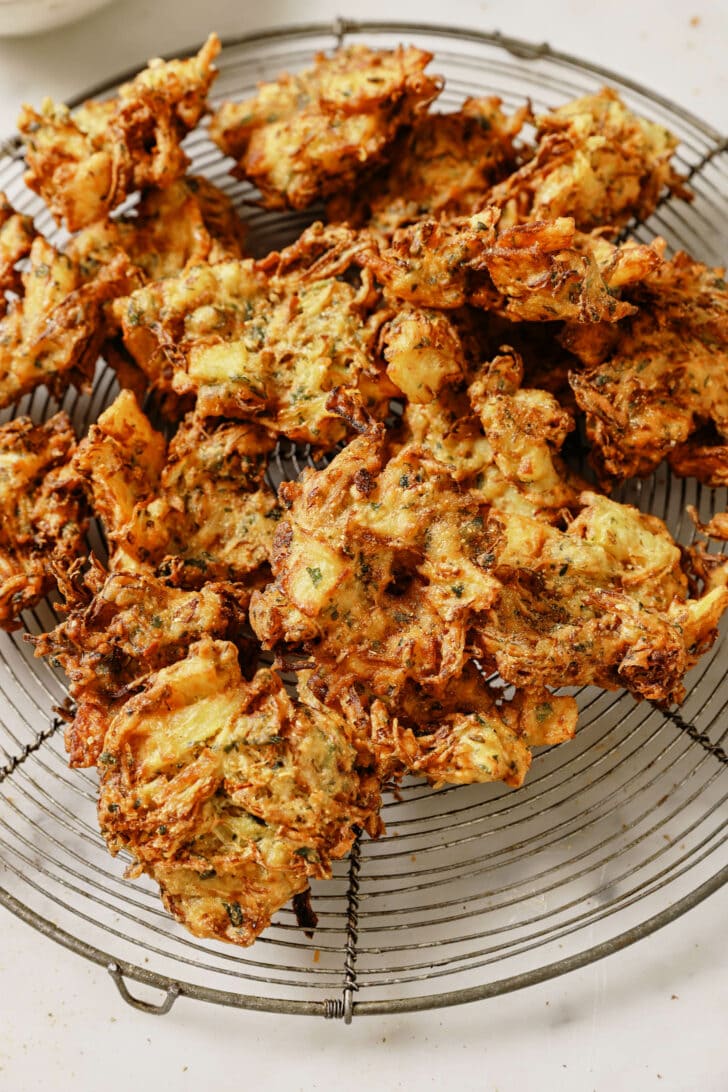
5 Tips to Make Crispy Pakoras
Pakoras are a kitchen sink type of snack recipe, more about intuition than precise measurements. But when it comes to making and keeping them crispy, there are a few key tips:
- More veggies and less gram flour batter = light, airy, crispy. Using too much gram flour/besan will give you doughy or floury pakoras.
- Add water, and that too cold/ice water. This is a tip I learned from my recipe tester and I tested to confirm it works. (More on this below.)
- The way you place the pakora batter in the hot oil matters. Drop them in so they’re not pudgy or too dense around the middle. Uneven pakoras with wispy edges are the goal for maximum crunch.
- Fry them until they’re golden brown for that satisfying crunch! Undercooked pakoras won’t be as crispy.
- Keep the oil on medium heat.
- Oil too cool = oily, soggy pakoras.
- Oil too hot = brown on the outside, raw on the inside.
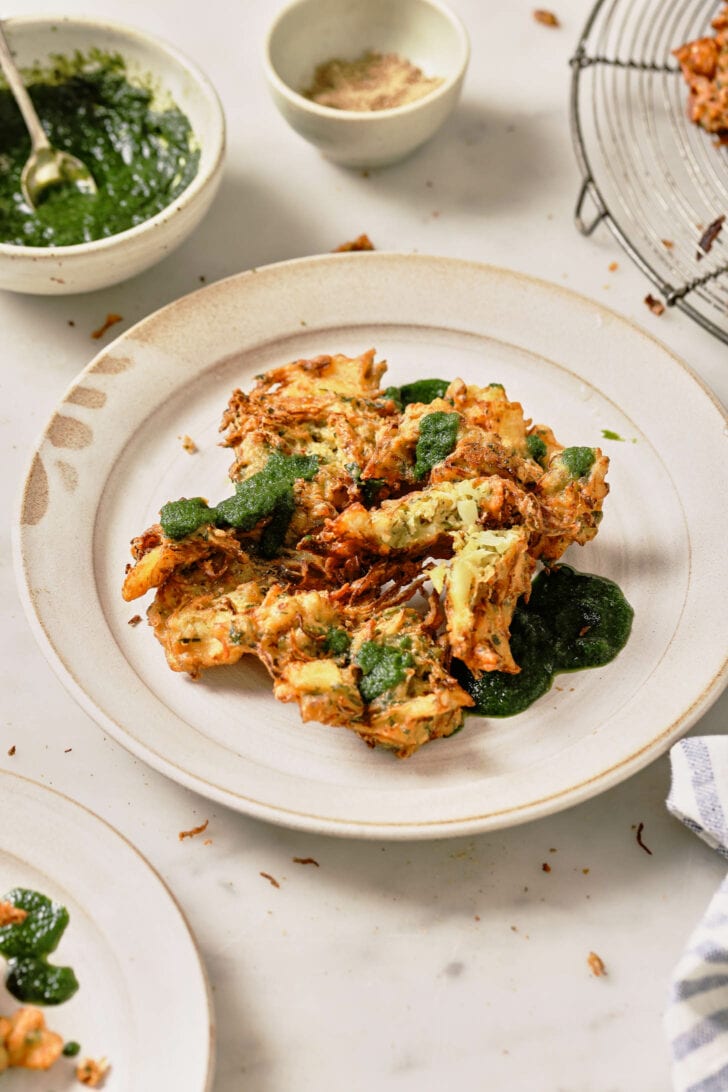
Ingredients for Pakora
The ingredient quantities aren’t written in stone, and you can use more or less of each ingredient once you discover what you like.
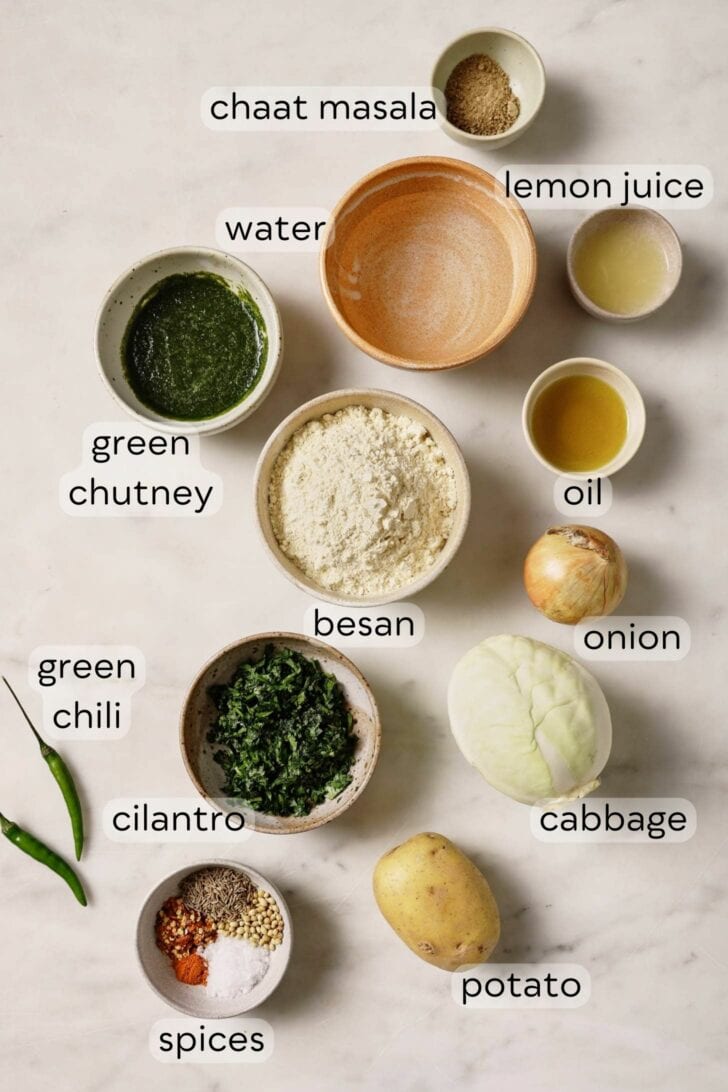
Vegetables
- Potato: There is no right way to cut the potatoes, as long as you get thinly sliced wedges or rectangles. As a general rule, for small potatoes, cut them in quarters lengthwise and then slice each quarter thinly into 1/6-1/4” thick pieces. For medium/large potatoes, cut them into 6-9 wedges (so that each wedge is ~1” thick) and then thinly slice them into 1/6-1/4” inch thick pieces. The important thing is that the potatoes are thin enough to cook through when frying but not too small to separate from the pakora mixture while frying.
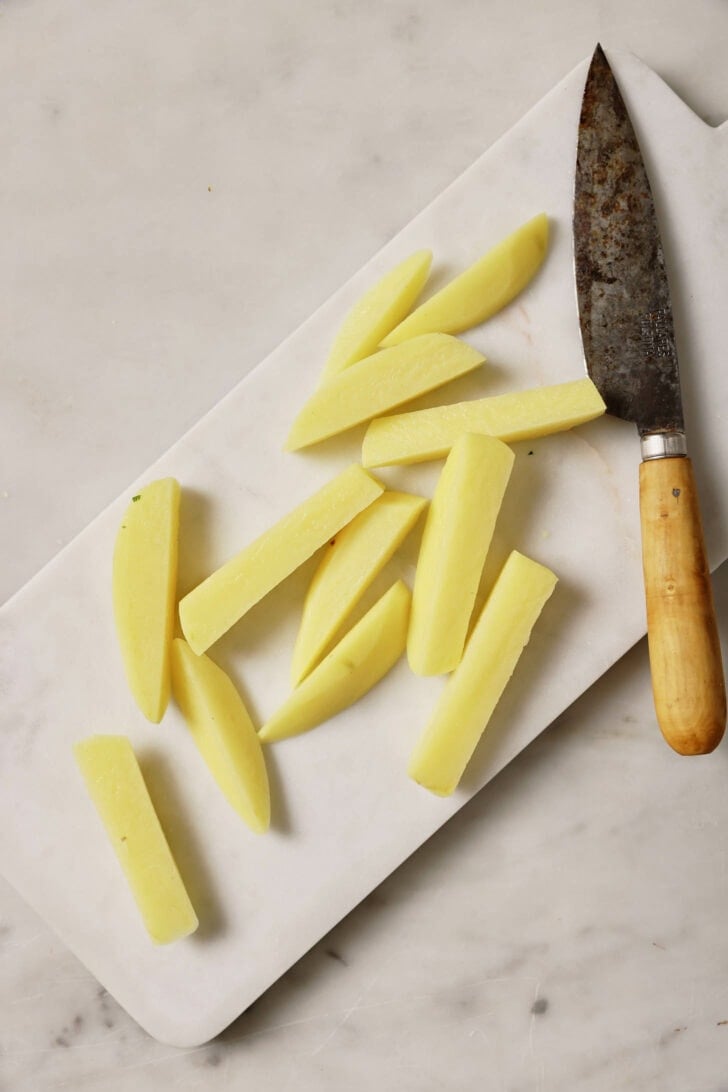
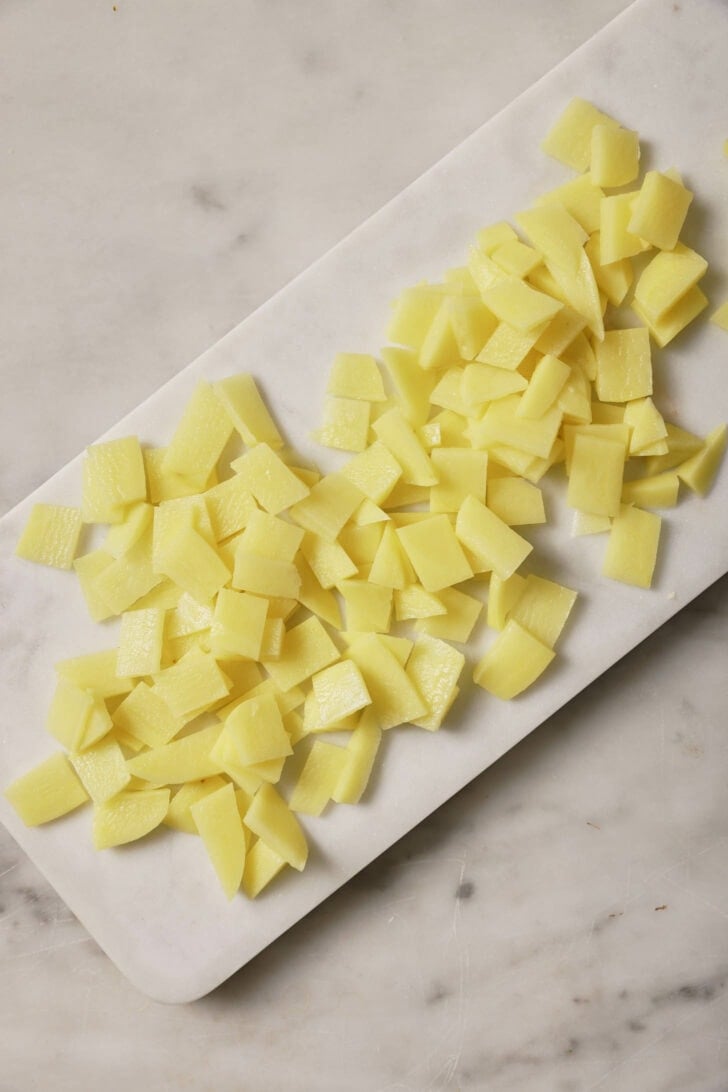
- Onion: Use yellow or red onion. If you have small onions, halve and thinly slice. For larger onions, quarter and thinly slice.
- Cabbage: I love red cabbage for its color and texture, but green works just as well. I like to use packets of shredded mixed cabbage instead of buying the whole head.
- The cabbage is somewhat of a placeholder veggie. See below for a list of vegetables you can use.
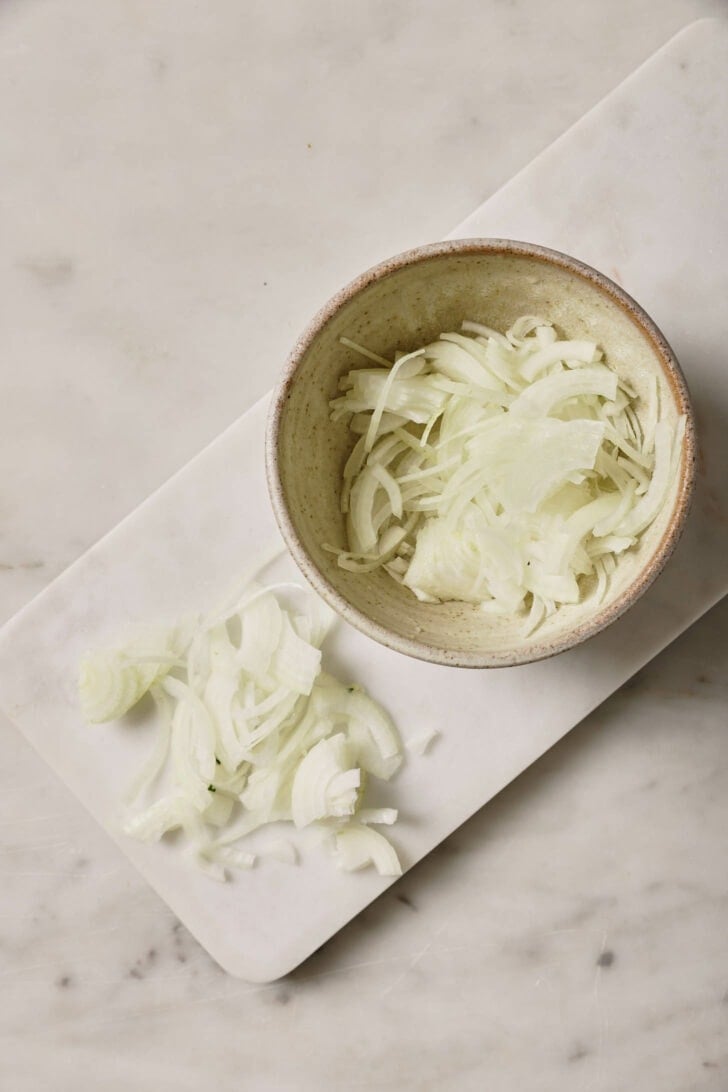
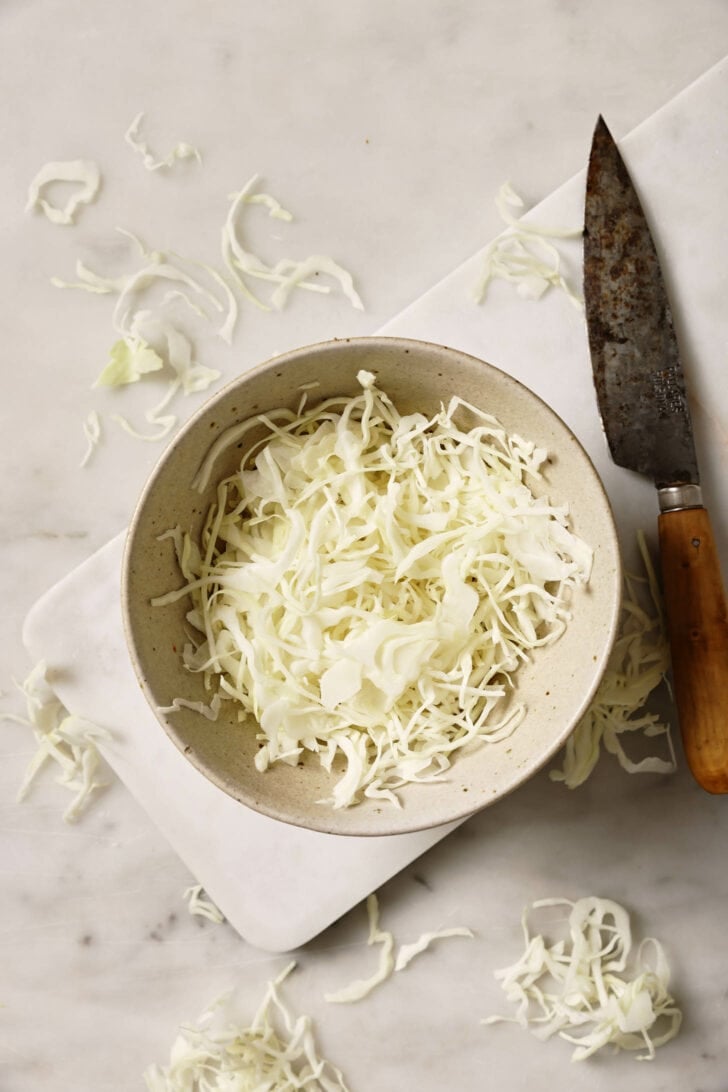
Suitable Vegetables for Pakora:
You can make pakoras with all kinds of vegetables, as long as they’re small enough to cook through and large enough to hold to the batter. Replace cabbage with 1 measurement cup as opposed in 60g in weight. Chop all veggies into strips or bite-sized pieces.
- spinach – 1 cup/30g. You may even use thawed frozen spinach (~60g). Squeeze out water before using.
- Roma tomato – (deseed and remove pulp) – use 1/2, up to 1 tomato instead of full cup
- cauliflower
- eggplant
- zucchini
- carrots
- bell peppers
- beetroot
- mushrooms
- broccoli
More Ingredient Notes
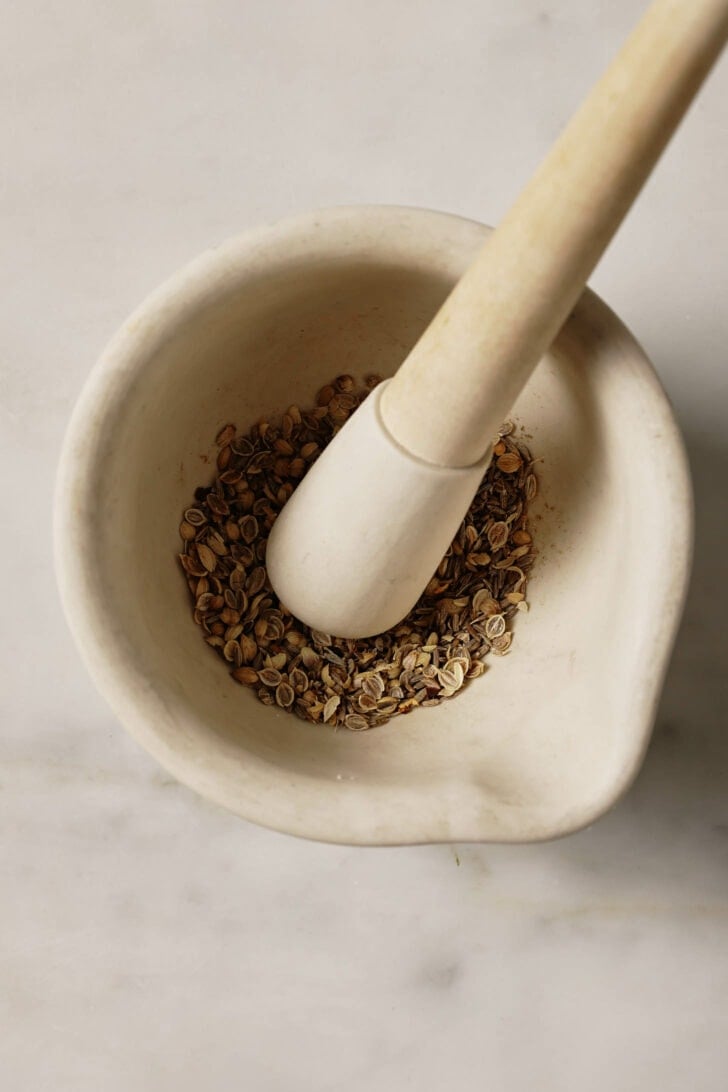
- Besan/gram flour: Quality matters here. Look for expiration dates! Tested with Deep and Laxmi brand besan/gram flour, which is made with chana dal. If you can’t find it, substitute it with chickpea flour/garbanzo bean flour which is available at most grocery stores.
- Cold water: Many recipes skip adding any water, allowing the vegetables to be the only source of moisture. But I find this creates dense pakoras. Water keeps them light and airy.
- Why cold water? Just as cold water inhibits gluten development in flour, it helps keep the besan/gram batter perked up. It may also create temperature shock between the hot oil and cool pakoras, helping them crisp up while remaining soft inside.
- Serrano: I opt for serrano because it’s less spicy than Thai/bird’s eye, so you can add more flavor with tolerable heat. If you’re able to find Indian/finger chili’s, that’s even better. Deseed to reduce heat.
- Cilantro: Use generously for vibrant flavor and color.
- Red chili flakes + powder: Flakes provide texture while powder brings gentle heat to the batter.
- Coriander and cumin seeds: Roughly crush whole seeds for better texture. Sub equal amount homemade coriander powder or cumin powder.
- Oil: Binds the mixture and keeps the pakoras soft and tender on the inside.
- Lemon juice: Essential for tang and chatpata flavor. Sub 1/2 tsp chaat masala or amchur within the batter.
- Baking soda: Makes the pakoras slightly fluffier while still keeping them crispy. I kept baking soda optional because the batter is light and airy already. May sub baking powder.
- Chaat Masala: Optional, for sprinkling on top. Makes them more street-style.
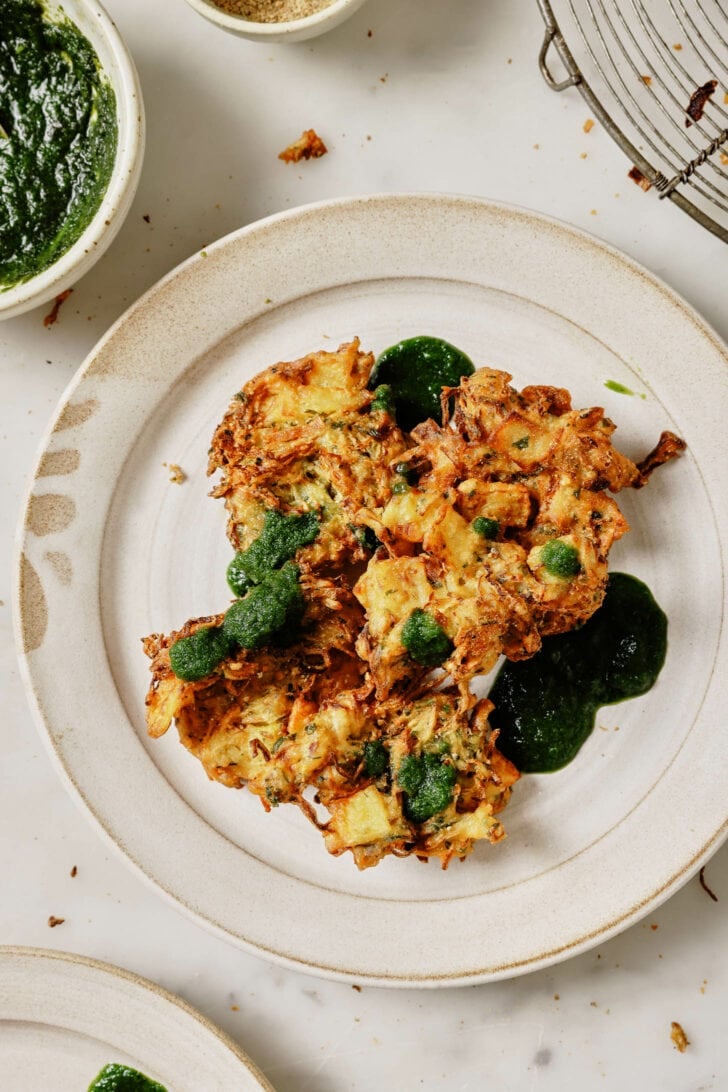
How to make Pakoras
Tip: I like to get my oil started on low heat while I prepare the pakora mixture.
Make Pakora Mixture
- Combine all the pakora mixture ingredients except for besan, water, and baking soda (if using). Toss the ingredients together before adding the besan.
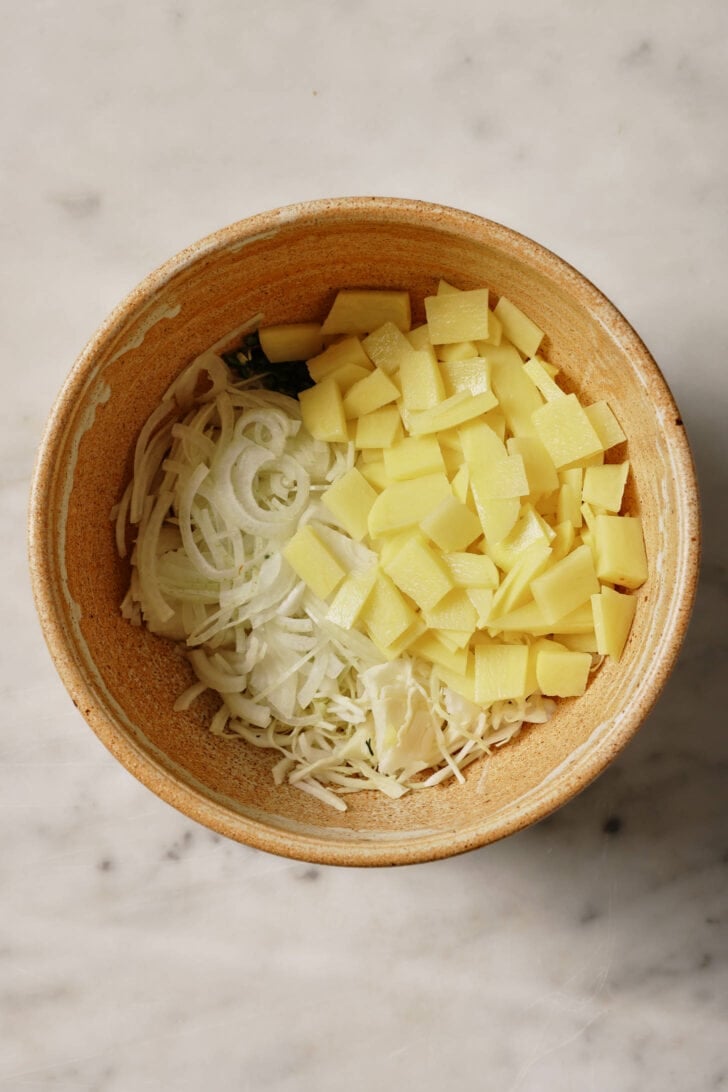
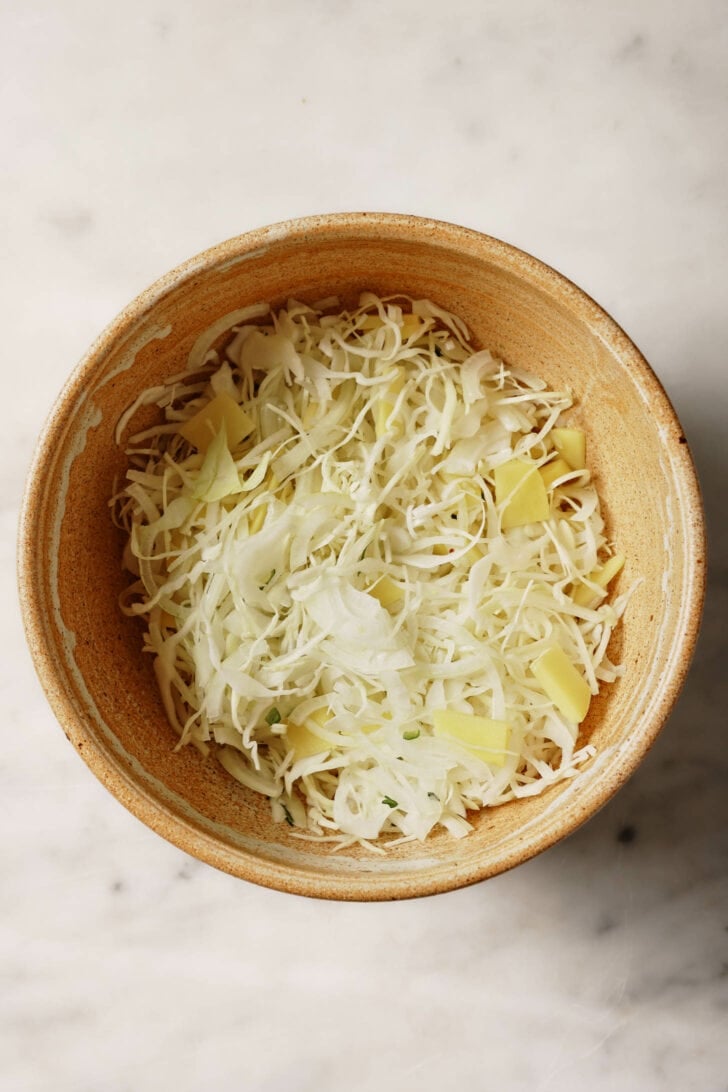
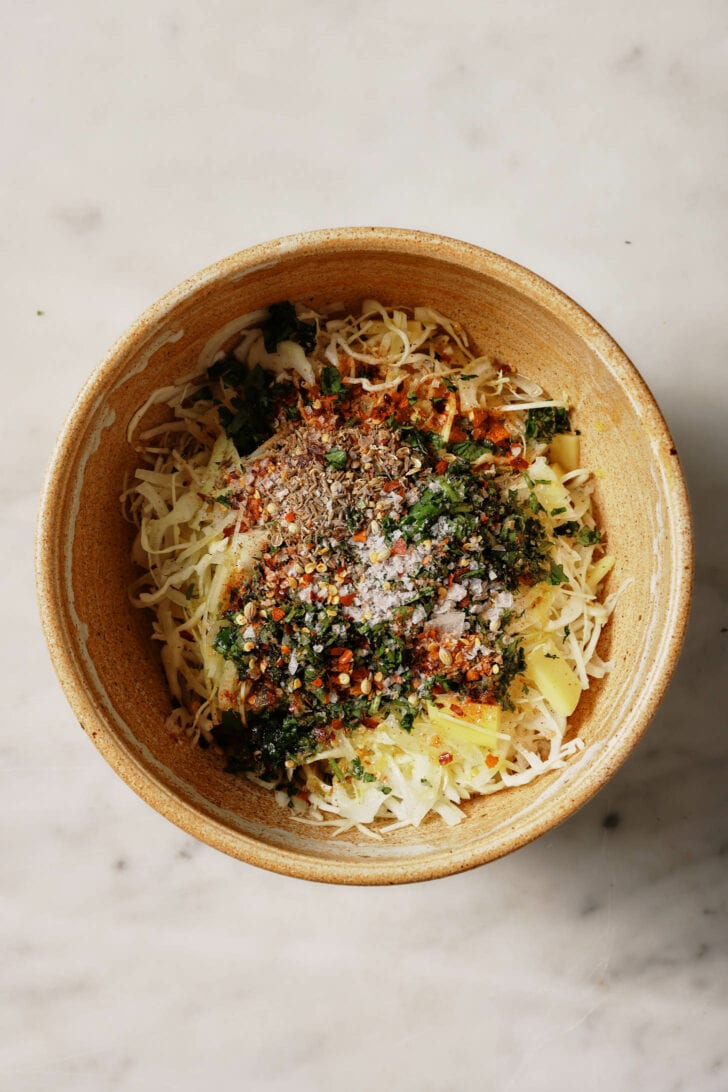
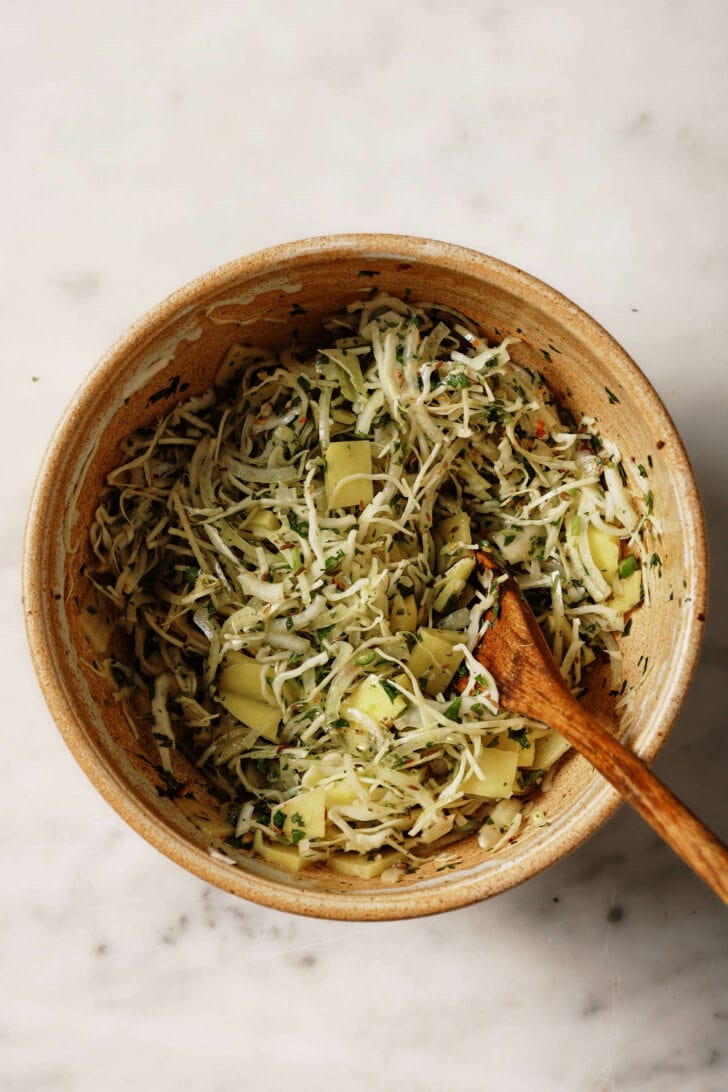
- Mix in the besan and toss to combine until the vegetables are lightly coated. Don’t worry if the vegetables look bare or the flour clumps due to moisture. It will all become together once you add the water.
- Next, add water, bit by by bit, so that the mixture coated and homogeneous. The recipe calls for just enough water so that the mixture holds together. It’s important that there not be any dry flour or wet batter settled at the bottom of the bowl.
Troubleshooting Tips: The moisture increases depending on whether you use more vegetables, let them sit longer, or work the mixture more vigorously. To address this, add less water or more besan.
-If the mixture is too loose/wet toward the bottom, distribute the moisture by mixing it again. After mixing, if it’s still watery, add 1-2 tbsp gram flour until it’s homogeneous.
-If it’s too dry, allow it to sit until the vegetables release their moisture. You should not need any more water than called for in the recipe.
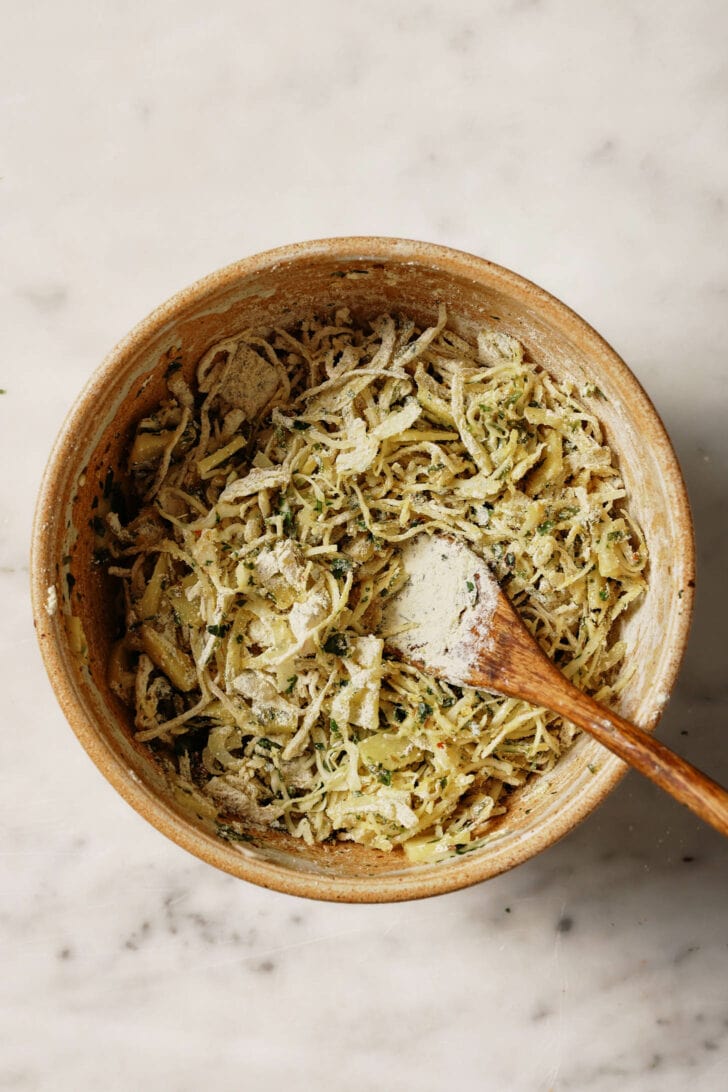
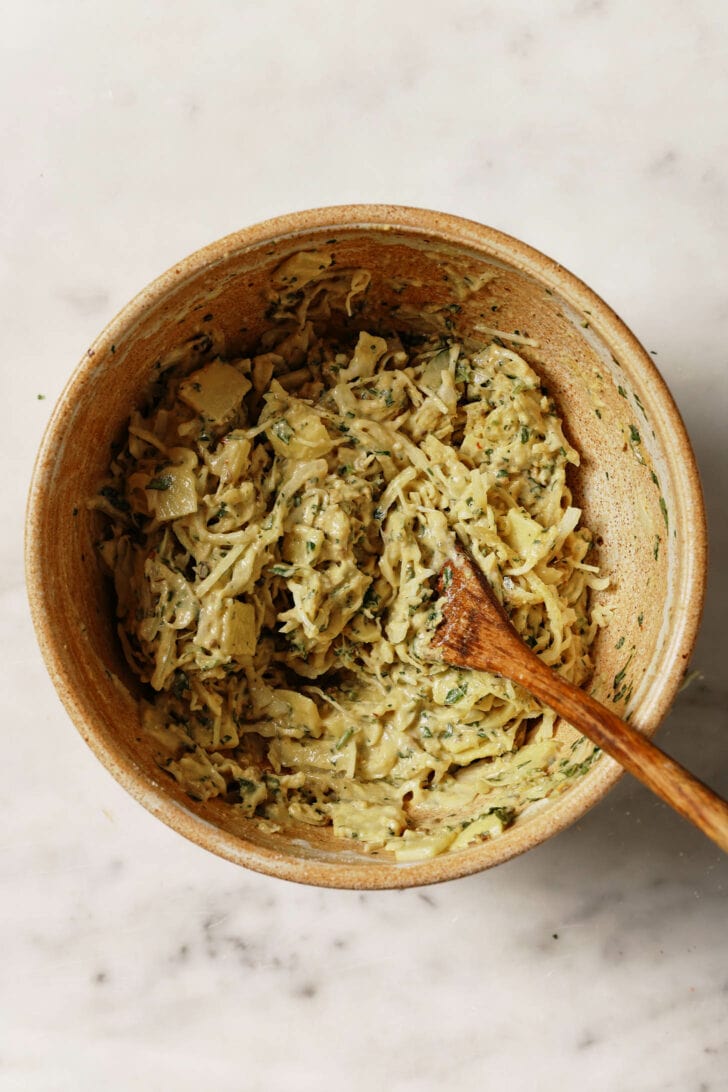
Type of pan: You can use just about any pan, as long as it’s somewhat deep. A wider pan is beneficial so you can fit more pakoras in and therefore spend less time frying. If you use a shallow fry pan, you can get away with using less oil (like I do in my Pan-Fried Pakora Recipe). They won’t turn out as crispy, but it still works!
Fry Pakoras
- Now comes the fun part. 😂 Frying! If your oil was already heating on low, crank it up to medium heat. Throughout frying, adjust heat as needed to maintain medium heat (300-320°F/150°-160°C) so they have time to fully cook on the inside. The oil is hot enough once the pakora mixture floats to the top.
- Gently lower a generous 1 tbsp of pakora mixture into the hot oil, making sure not to overcrowd the pan. Overcrowding will reduce the oil temperature, which, as I mentioned earlier, will make them oily and soggy.
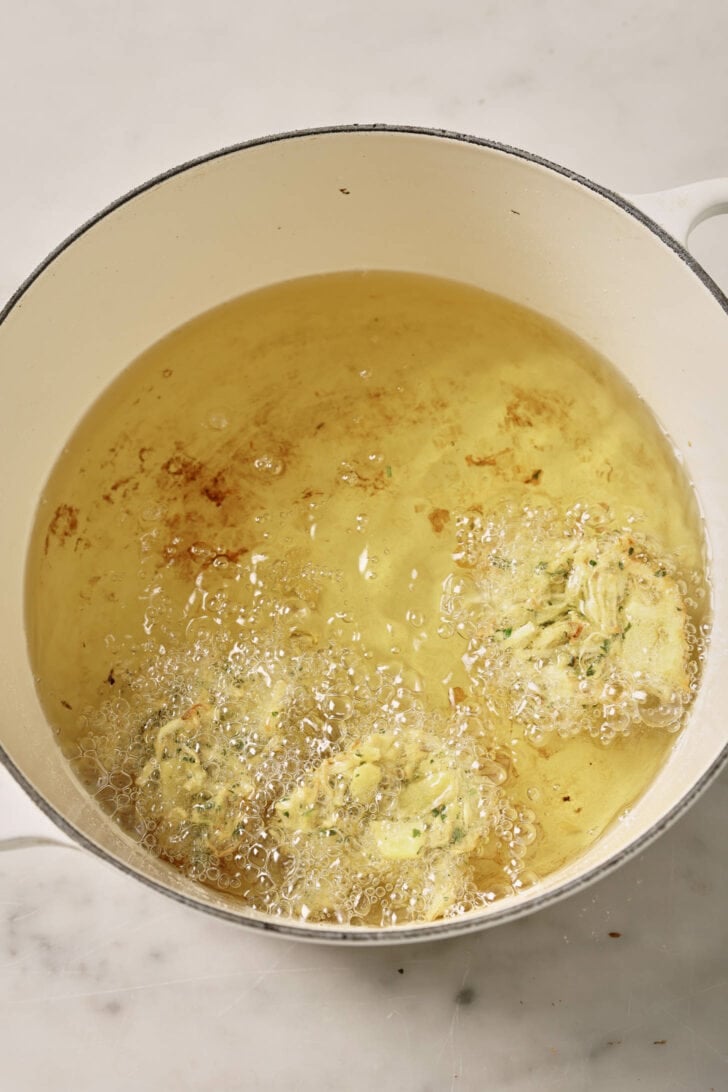
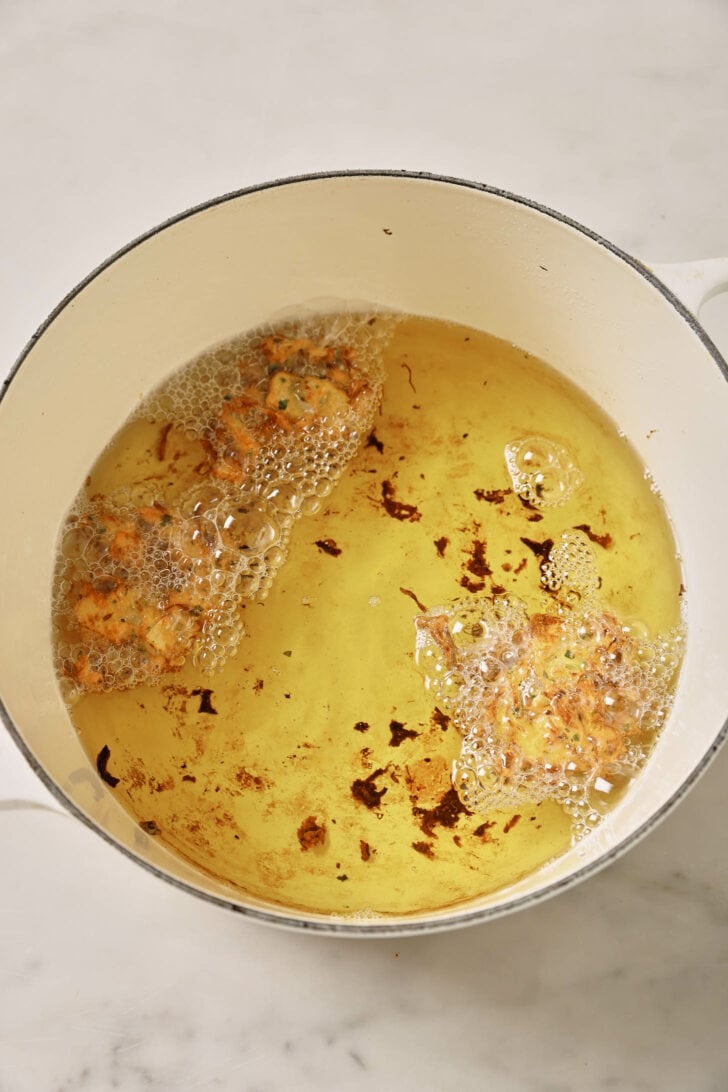
- Fry until golden brown. You don’t want to remove too early or they won’t be as crispy, but frying too long will give them a dark hue. Using a slotted spoon or spider strainer, transfer to a paper towel-lined plate if serving immediately. If not, place on a wire rack before placing in the oven at 200°F/95°C (Keep Warm setting).
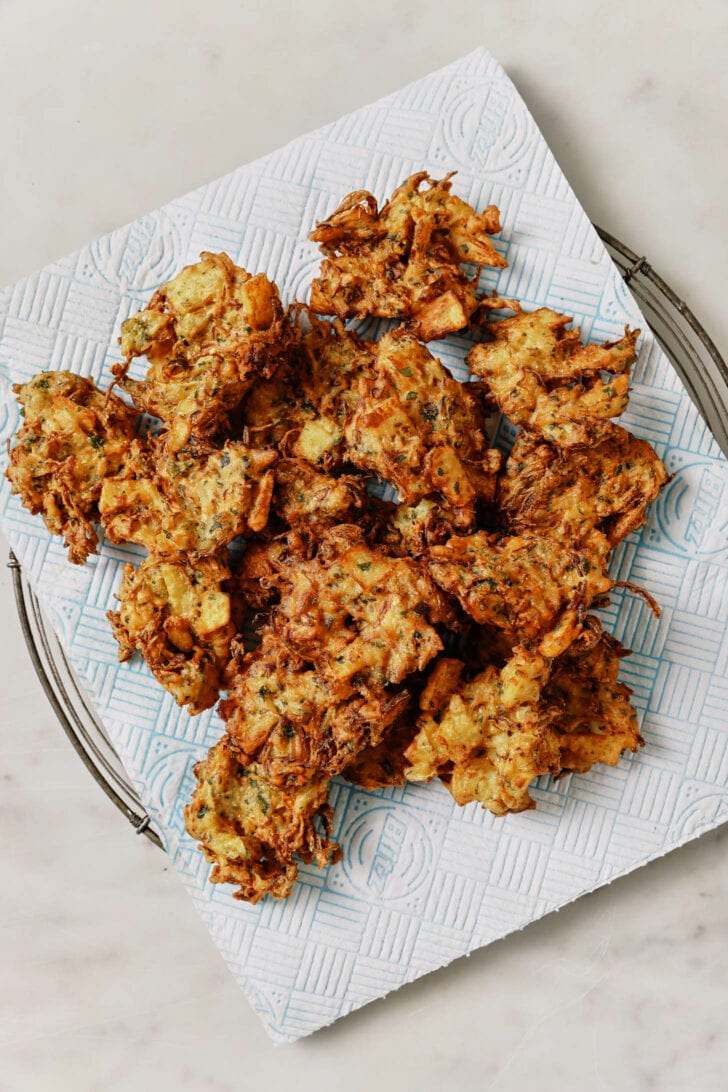
Variations/Add-ins
These are ingredients I’ve often used in Pakoras (like my Kadhi Pakora) but left out of the main recipe. Using too many of them at the same time can clutter the flavor:
- 2 tsp dried pomegranate seeds (anardana) – slight crunch and tang
- 1/4 tsp whole carom seeds (ajwain), roughly crushed using a mortar and pestle – earthy/umami flavor
- 1/2 tbsp dried fenugreek leaves (methi), crushed between the palms of your hands – earthy/herb flavor
- 1/2 tsp chaat masala or amchur (green mango) powder – tang
- 1/4 tsp turmeric powder – color
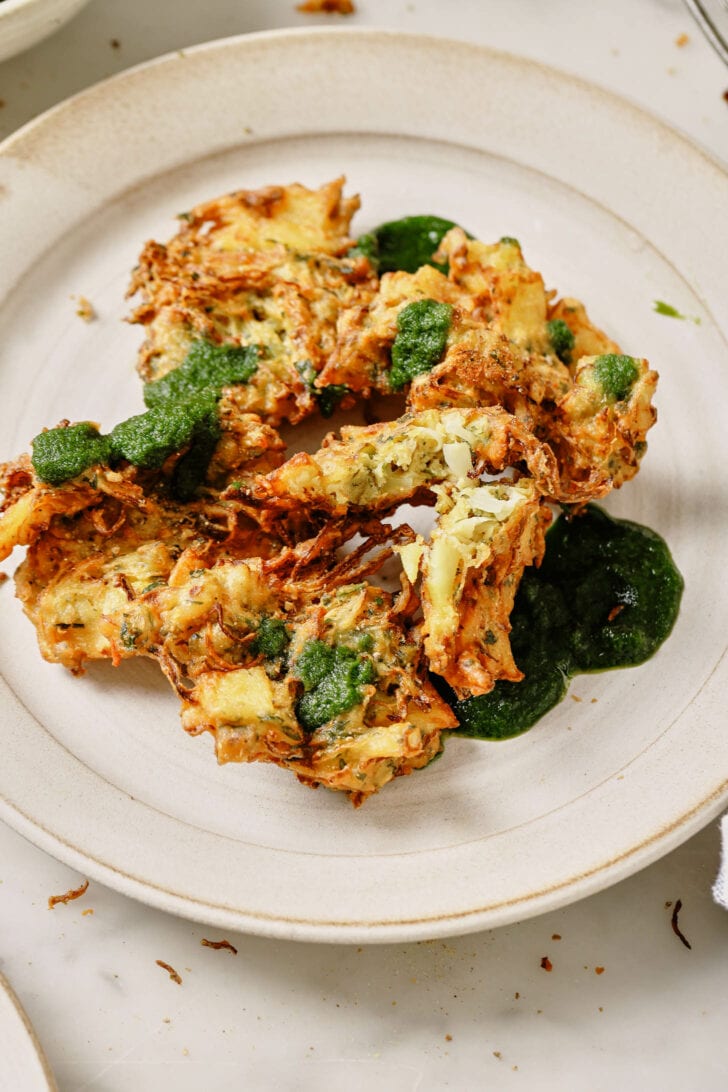
What Sauce to Serve with Pakora
Pakoras are best with any kind of chutney or sauce. My favorite is a simple Green Chutney (recipe below), but you can use Mint Raita, Imli ki Chutney, Sriracha, or Hot and Sweet Sauce. My kids love them with ketchup.
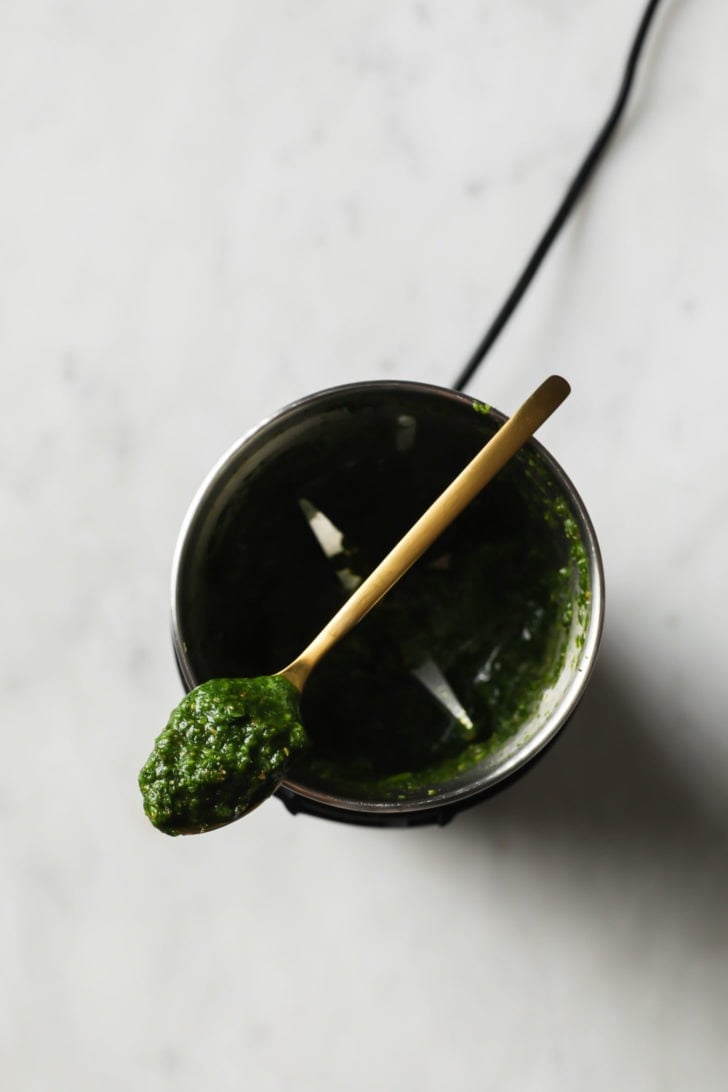
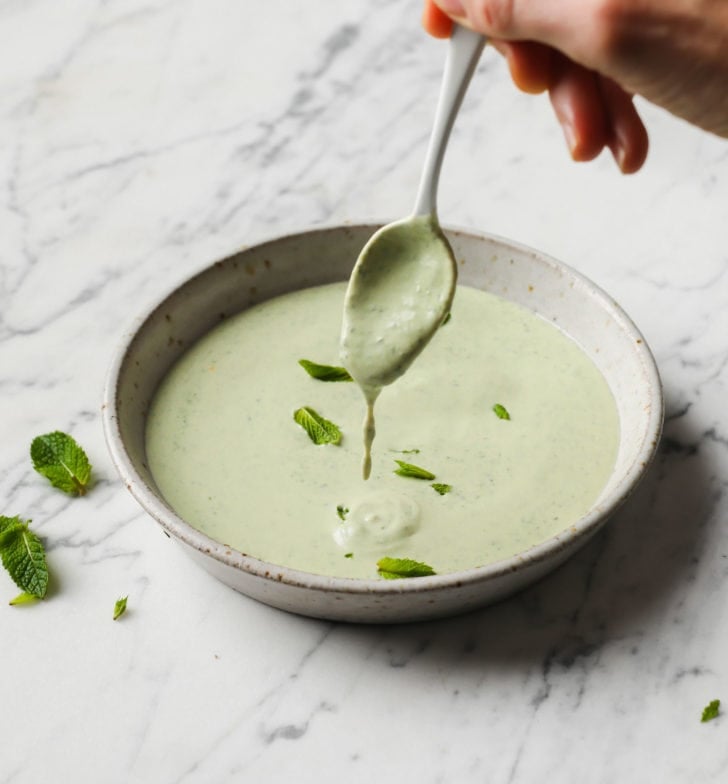
Quick Mint and Cilantro Green Chutney
This is like my mint raita but without the yogurt.
- 1/2 cup (~12 g) cilantro leaves
- 3 tbsp (~4 g) mint leaves, try not to use stems
- 1/2 small Serrano pepper or small Thai green chili pepper, deseeded (choose how thick the slice depending on how spicy you’d like)
- 1/8 tsp sea salt, more or to taste
- 1/2 garlic clove
- 1 tsp lemon or lime juice
- 1/8 tsp sugar
- 2-3 tbsp water, as needed to blend
- Add all the ingredients to a small blender or spice grinder. Blend, until it reaches a fine consistency. If needed, add 1-2 tablespoons more water to make it easier to blend. It should become a runny paste, with the leaves no longer visible. If needed, strain excess water to get the desired consistency.
Make-Ahead Tips
I would not recommend frying pakoras more than a few hours in advance. If you’re not serving immediately, place on a wire rack instead of a paper-towel lined plate as they’ll steam up and soften. If you’re serving within an hour, place the wire rack into a warm 200°F/95°C oven until ready to serve. Otherwise, cover and store at room temperature until ready to reheat.
How to Reheat
Pakoras keep well in the fridge in an airtight container. To reheat, bake at 350°F/175°C until heated through. If you own an air-fryer, I find it’s best at reheating Pakoras! Air-fry at 350°F until heated through.
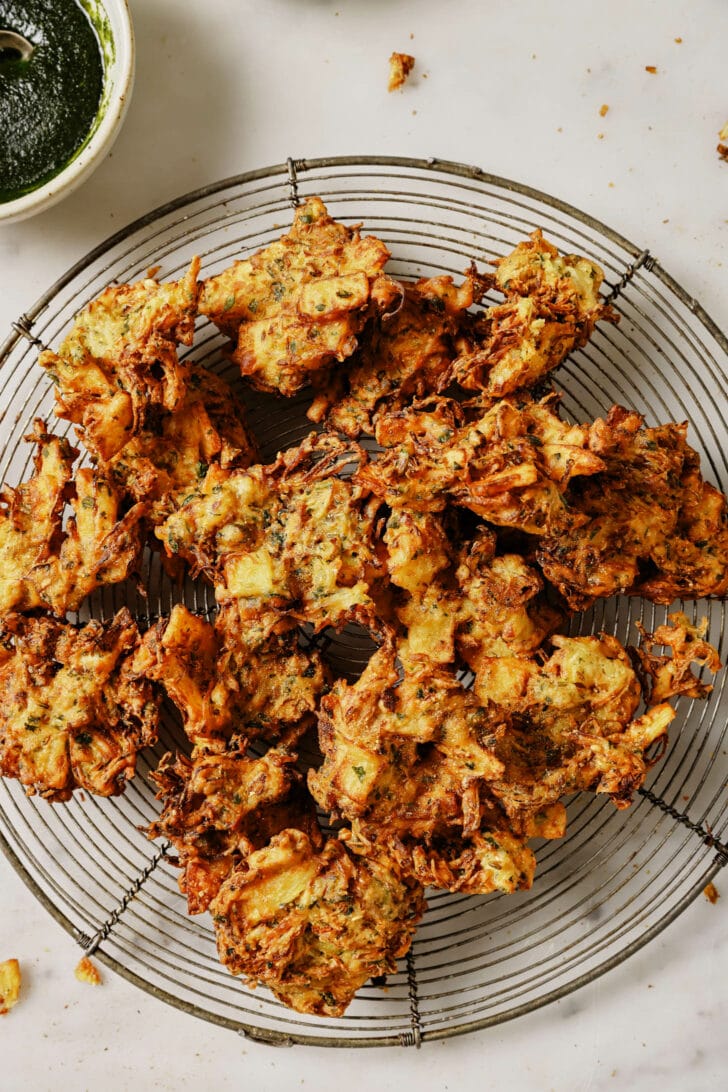
Dry Pakora Mix Recipe
A great option for Ramadan is to combine and store the dry ingredients and add the fresh and wet ingredients when you’re ready to make the Pakoras. If you 3x the recipe, you’ll have enough Dry Pakora Mix to make this recipe 3 times. Here are the dry ingredients in 3x the quantity:
- 3.75 cup (~570 g) besan (gram flour)
- 3 tbsp coriander seeds, roughly crushed using a mortar & pestle
- 2 tbsp cumin seeds, roughly crushed using a mortar & pestle
- 2 tbsp red chili flakes
- 1.5 tsp red chili powder or cayenne pepper
- 2 tbsp sea salt/table salt
- 1/4 tsp heaped baking soda
My friend Sarah from Flour & Spice Blog has more tips on using a Pakora Mix.
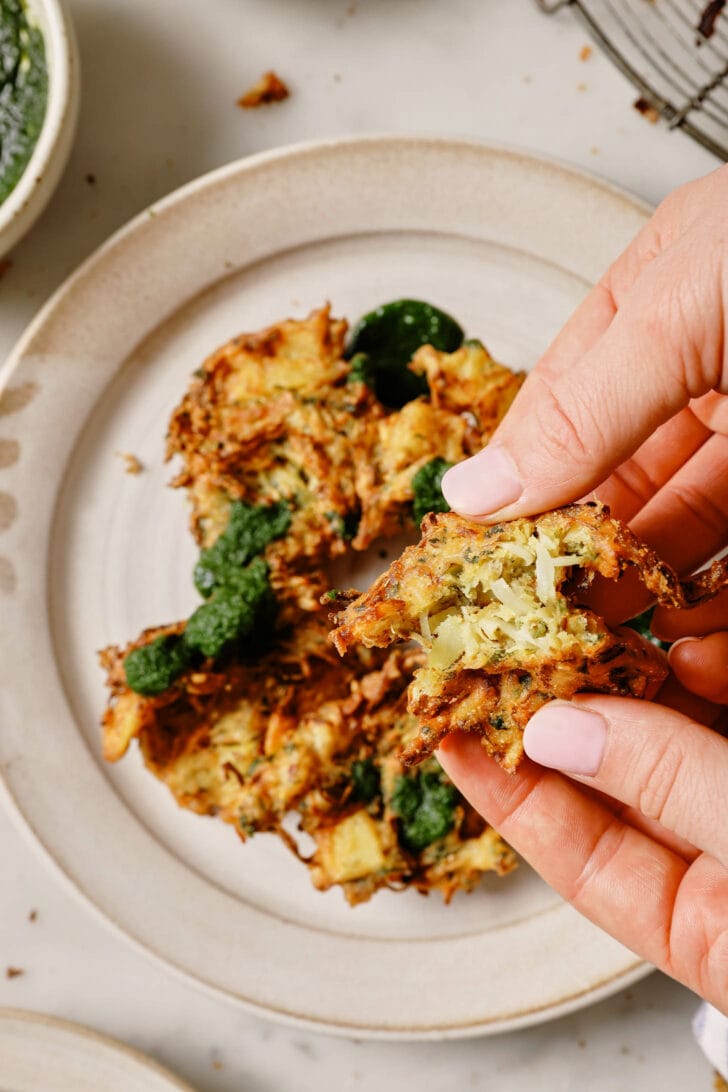
Tried this recipe? If you have a minute, please consider leaving a comment telling me how it was! If you have a photo of your dish, please feel free to upload it and share with others. If you’re on Instagram, please tag me so I can see your creations. I truly love hearing from you. Thank you!
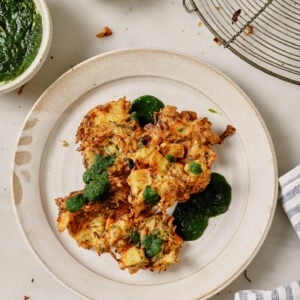
Crispy Pakora Recipe (Simple, Homestyle)
Watch the Video
Ingredients
Pakora
- 1 large (250 g) yellow onion, quartered and thinly sliced
- 1 medium (220 g) Russet potato, peeled, quartered/cut into wedges lengthwise and thinly sliced (Note 1)
- 1 cup (60 g) red or green cabbage, thinly sliced into 1” pieces (sub 1 cup/30g chopped spinach or your choice of veggie – Note 2)
- 2 (25 g) Serrano peppers, finely chopped (deseed for less heat)
- 1/2 cup (14 g) cilantro, stems included, finely chopped
- 2 tsp red chili flakes
- 1/2 tsp red chili powder or cayenne pepper
- 1 tbsp coriander seeds, roughly crushed using a mortar & pestle
- 2 tsp cumin seeds, roughly crushed using a mortar & pestle
- 1 tbsp neutral oil, such as grapeseed oil, plus more for frying
- 1 tbsp lemon juice
- 2 tsp sea salt/table salt
- 1 1/4 cup (~190 g) besan (gram flour), Note 3
- 1/2 cup + 1 tbsp chilled water, Note 4
- 1/8 tsp baking soda, optional – Note 6
To Serve
- Chaat masala, optional, for sprinkling on top
- Mint chutney, optional, for serving
Instructions
- Make Pakora Mixture: In a medium bowl, combine the ingredients listed under 'Pakora' except besan/gram flour, water, and baking soda. Stir in besan and mix to combine so that the vegetables are lightly coated (okay if besan starts to clump up). Add measured water, bit by bit, until the mixture is coated but not runny. Taste and adjust seasoning, adding salt to taste, cumin/coriander for earthiness, red chili flakes/powder for heat, and lemon for tang. Lastly, mix in the baking soda, if using. Set aside. The vegetables will release their own moisture and the mixture will become thinner. (See Troubleshooting Tips)
- Preheat oil: Heat a large frying pan or heavy-bottomed pot over medium heat. Add oil so that it’s about 1.5-2”/4-5 cm deep. It should be deep enough so that the batter doesn’t stick to the bottom. Once the oil is hot, adjust heat level as needed to maintain medium heat (300-320°F/150°-160°C).
- Fry Pakoras: Gently lower a generous 1 tbsp of pakora mixture into the hot oil, making sure not to overcrowd the pan. (I like to use tongs to pick up the mixture and lower into the oil.) To make them as crispy as possible, try to shape them flat and uneven instead of round and pudgy. Onion sticking out and uneven/wispy edges is a good thing. Fry, turning often, until crispy and golden brown all over, 8-10 minutes. You want to maintain medium temperature to ensure they have time to fully cook from the inside.
- Remove: Use a slotted spoon to transfer the pakoras onto a paper towel-lined plate (if serving immediately) or wire cooling rack (if serving later – Note 5). Repeat until all pakoras are cooked. Sprinkle with chaat masala if you'd like. Serve immediately with Green Chutney (quick recipe in post), Mint Raita, or sauce of choice.
Notes
-If the mixture is too loose/wet toward the bottom, distribute the moisture by mixing it again. If it’s still watery, add 1-2 tbsp gram flour until it’s homogeneous.
-If it’s too dry, allow it to sit until the vegetables release their moisture. You should not need any more water than called for in the recipe.


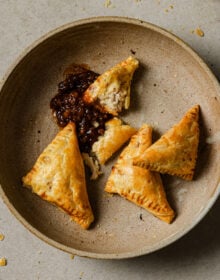
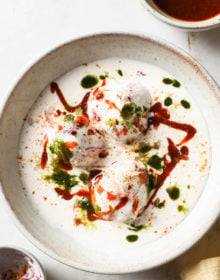
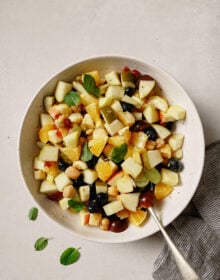

4 Comments on “Crispy Vegetable Pakora Recipe (Simple, Homestyle)”
Salam Alaykum. I really enjoy your website / recipes and tips. I have a question regarding pakoras.
If we add the baking soda they always tend to be more soft and plump verses crispy for me. What am I doing wrong? I want the besun sticking to my veggies and the pakoras crispy.
W.S. Shafia, thank you! Happy you enjoy the recipes. Hmm that sounds like too much baking soda. Did you add the amount listed in this recipe and they were still too soft and plumpy? I would just omit baking soda altogether next time. This recipe is definitely besan sticking to the veggies & crispy and not plump and fluffy.
Thank you for the great recipe! My first time making parkoray was a success and impressed my Pakistani husband for Iftar. Thanks again for all of your amazing Pakistani recipes! Always delicious and easy to follow 🙂
So glad to hear the first time was a success, Danielle! Thank you for sharing!